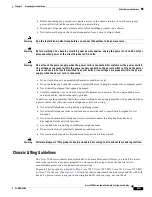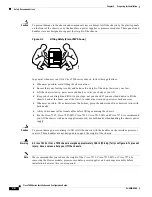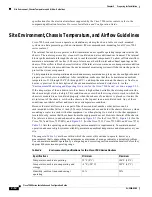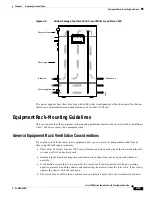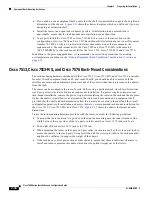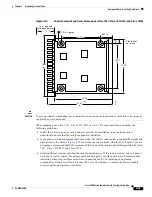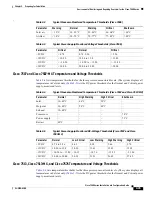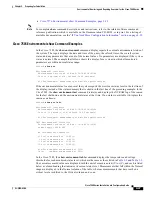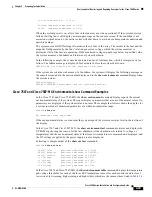
2-14
Cisco 7500 Series Installation and Configuration Guide
OL-5008-03 B0
Chapter 2 Preparing for Installation
Site Environment, Chassis Temperature, and Airflow Guidelines
Cisco 7507 and Cisco 7507-MX Airflow Considerations
The system blower on the Cisco 7507 and Cisco 7507-MX provides cooling air for the processor
modules. The blower draws air in through the air filter in the front chassis panel and directs it up through
the floor of the internal slot compartment and over the cards. The exhaust air is forced out the rear of the
chassis above and to each side of the processor slots. The blower needs a clean air filter in order to draw
in sufficient amounts of cooling air; excessive dust in the filter will restrict the airflow. Keep the air filter
clean and replace it when necessary.
Figure 2-8
shows the system blower and airflow through the Cisco 7507 and Cisco 7507-MX.
Figure 2-8
Airflow Through the Cisco 7507 and Cisco 7507-MX
Sensors on the RSP2 (for example) monitor the inlet and internal chassis air temperatures. If the air
temperature at either of the sensors exceeds a desired threshold, an environmental monitor displays
warning messages and can interrupt system operation to protect the system components from possible
damage from excessive heat or electrical current.
The power supplies have their own fans. An air dam between the power supply bays and the processor
module compartment keeps the airflow constant.
Cisco 7513, Cisco 7513-MX, and Cisco 7576 Airflow Considerations
The blower on the Cisco 7513, Cisco 7513-MX, and Cisco 7576 provides cooling air for the processor
modules. The exhaust air is forced out the front of the chassis behind the card cage.
Figure 2-9
shows the system blower and airflow through the Cisco 7513, Cisco 7513-MX, and Cisco
7576.
H3882
Power
supplies
Front of
chassis
Rear of
chassis
Air dam
6
Air dam
System
blower
5
4
3 (RSP2)
2 (RSP2)
1
0
Top view of router




